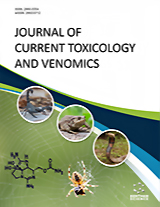Abstract
Buthus martensii Karsch (BmK) scorpion venom and its extracts are compounds found to contain a mixture of peptides with antitumor and analgesic activities. The extracts also contain polypeptides, lipids, nucleotides, mucoproteins, and other unknown substances showing potential therapeutic application. Finding medically relevant toxins, a range of peptides have been purified from BmK scorpion venom. These scorpion toxins are believed to modulate pain pathways to treat pain and cancer. This study aims to review the literature on BmK scorpion peptides with dual functions, their analgesic effects, and their mechanism of action in pain treatments and cancer. We reviewed the literature published between 1990 and 2023 from various databases and identified 68 articles suitable for our narrative review. In 1994, the first BmK scorpion peptide with an analgesic effect was purified. Since then, more analgesic peptides have been purified, including BmK AGAP, BmK AGAP-SYPU2, BmK AGP, BmK AGP-SYPU1, BmK AGP-SYPU2, BmK AS, and BmK iT2. Studies have demonstrated that these peptides bind to voltage sodium channels and inhibit the inactivation of the activated sodium channels to block neuron transmission. The analgesic activities of these peptides have been examined on different pain stimuli, resulting in strong analgesic and antitumor effects. Moreover, the antitumor activities of these peptides have been investigated in vitro and in vivo. The findings showed that the analgesic peptides may have antitumor effects. Based on their dual functions, these peptides have the potential to be developed as practical therapeutic agents for the treatment of cancer-related pain.
[http://dx.doi.org/10.2147/CEOR.S181192] [PMID: 30464561]
[http://dx.doi.org/10.1093/annonc/mdp001] [PMID: 19244085]
[http://dx.doi.org/10.4103/0973-1075.156467] [PMID: 26009666]
[http://dx.doi.org/10.3322/canjclin.57.2.75] [PMID: 17392385]
[http://dx.doi.org/10.1002/14651858.CD011108.pub3] [PMID: 34350974]
[http://dx.doi.org/10.1111/j.1526-4637.2010.00983.x] [PMID: 21040438]
[http://dx.doi.org/10.4103/0970-9185.81820] [PMID: 21772673]
[http://dx.doi.org/10.1093/jncimonographs/lgh012] [PMID: 15263038]
[http://dx.doi.org/10.18632/oncotarget.2894] [PMID: 25686831]
[http://dx.doi.org/10.3389/fphys.2017.00510] [PMID: 28798691]
[http://dx.doi.org/10.2147/DDDT.S231008] [PMID: 32161447]
[http://dx.doi.org/10.1007/s41048-018-0067-x] [PMID: 30533488]
[http://dx.doi.org/10.1016/B978-0-12-814043-7.00023-6]
[http://dx.doi.org/10.1016/j.toxicon.2020.12.017] [PMID: 33387549]
[http://dx.doi.org/10.1016/j.actatropica.2008.05.021] [PMID: 18579104]
[http://dx.doi.org/10.1177/1535370213513991] [PMID: 24599885]
[http://dx.doi.org/10.1007/s10989-018-9721-x] [PMID: 32214927]
[http://dx.doi.org/10.3389/fonc.2019.00021] [PMID: 30740360]
[http://dx.doi.org/10.1016/j.toxicon.2017.02.020] [PMID: 28242227]
[http://dx.doi.org/10.1016/j.cell.2019.07.014] [PMID: 31447178]
[http://dx.doi.org/10.1016/j.peptides.2013.10.023] [PMID: 24269605]
[http://dx.doi.org/10.1002/bmc.1519] [PMID: 20945457]
[PMID: 22295565]
[http://dx.doi.org/10.1016/S0167-4838(01)00241-2] [PMID: 11566364]
[http://dx.doi.org/10.1034/j.1399-3011.2001.00869.x] [PMID: 11454167]
[http://dx.doi.org/10.1016/S0168-0102(00)00164-4]
[http://dx.doi.org/10.1093/oxfordjournals.jbchem.a124691] [PMID: 7706233]
[http://dx.doi.org/10.1007/s00894-012-1666-y] [PMID: 23179767]
[http://dx.doi.org/10.3389/fphar.2016.00496] [PMID: 28066245]
[http://dx.doi.org/10.1155/2013/958797] [PMID: 23843786]
[http://dx.doi.org/10.1016/j.toxicon.2006.09.023] [PMID: 17087986]
[http://dx.doi.org/10.1016/j.bbrc.2010.02.179] [PMID: 20206129]
[http://dx.doi.org/10.1007/s12264-013-1377-0] [PMID: 24132796]
[http://dx.doi.org/10.1016/j.peptides.2019.02.009] [PMID: 30858089]
[http://dx.doi.org/10.1007/s10930-014-9547-0] [PMID: 24554422]
[http://dx.doi.org/10.1021/acs.biochem.5b00067] [PMID: 25919575]
[http://dx.doi.org/10.1016/j.ijbiomac.2017.01.020] [PMID: 28065753]
[http://dx.doi.org/10.1080/07391102.2020.1848626] [PMID: 33228478]
[http://dx.doi.org/10.5483/BMBRep.2010.43.12.801] [PMID: 21189156]
[http://dx.doi.org/10.1016/j.peptides.2006.03.026] [PMID: 16716457]
[http://dx.doi.org/10.1111/j.1476-5381.2009.00471.x] [PMID: 19912232]
[http://dx.doi.org/10.1002/1097-4547(20000901)61:5<541:AID-JNR9>3.0.CO;2-#] [PMID: 10956424]
[http://dx.doi.org/10.1016/S0041-0101(98)00190-1] [PMID: 10080355]
[http://dx.doi.org/10.1016/S0304-3940(00)01642-6] [PMID: 11121871]
[http://dx.doi.org/10.1016/S0028-3908(00)00168-4] [PMID: 11166328]
[http://dx.doi.org/10.1034/j.1399-3011.2000.00750.x] [PMID: 11083058]
[http://dx.doi.org/10.1371/journal.pone.0014510] [PMID: 21264295]
[http://dx.doi.org/10.1177/1744806918761238] [PMID: 29424271]
[http://dx.doi.org/10.1155/2020/4234273] [PMID: 33178316]
[http://dx.doi.org/10.1016/S1046-5928(02)00609-5] [PMID: 12597884]
[PMID: 21793303]
[http://dx.doi.org/10.1016/j.heliyon.2021.e08560] [PMID: 35005265]
[http://dx.doi.org/10.36303/SAJAA.2966]
[http://dx.doi.org/10.3389/fphys.2019.00708] [PMID: 31293432]
[http://dx.doi.org/10.1007/s10529-015-1936-8] [PMID: 26303431]
[http://dx.doi.org/10.3892/ol.2012.1049] [PMID: 23420047]
[http://dx.doi.org/10.1002/jcb.23166] [PMID: 21538480]
[http://dx.doi.org/10.1007/s12010-012-9768-7] [PMID: 22869257]
[http://dx.doi.org/10.2174/0929866525666180614114307] [PMID: 29921194]
[http://dx.doi.org/10.1016/S0361-9230(00)00355-5] [PMID: 11113589]
[http://dx.doi.org/10.1186/s40409-015-0043-6] [PMID: 26491429]
[PMID: 7993579]
[http://dx.doi.org/10.1016/j.phrs.2006.02.009] [PMID: 16616856]









